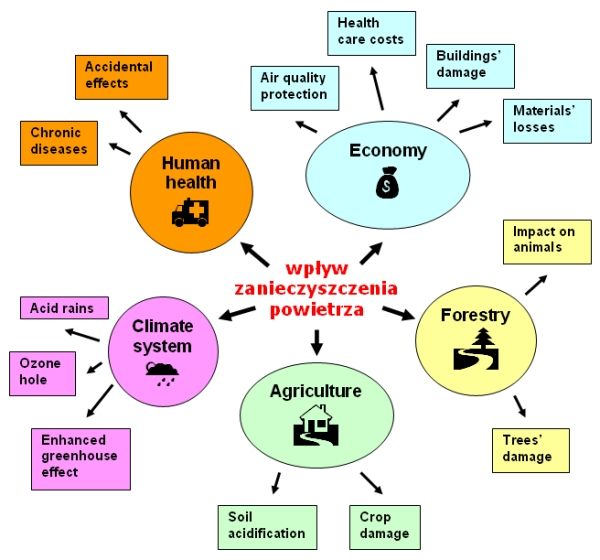|
|
 |
|
|
|
 |
| |
|
|
 |
Urban Climate
Read more |
The impact of air pollution (an overview)
Air pollution is potentially dangerous to our health, can damage the environment and is economically costly. Meteorological conditions modify, to a large extent, the effects of air pollution.
|
|
|
|
|
 |
|
Air pollution causes numerous diseases and can threaten human health and even life. The impacts of air pollution are usually gradual and cause chronic health problems. However, in some cases (see the "Urban bioclimate" section), air pollutants can cause sudden death. In the case of plants and agriculture, air pollution decreases harvests and causes acidification of the soil. In the case of forests, air pollution causes a decrease in productivity and direct damage to the trees.
As far as global climate change is concerned, the effects of air pollution on water and plant ecosystems are the most important as they affect how much CO2 is removed from the atmosphere.
|
 |
 |
|
1. Impact of air pollution. Authors: Anita Bokwa, Pawel Jezioro.
|
|
Air pollution is known to cause economic losses but quantifying the actual cost of air pollution is extremely difficult. The four main reasons why air pollution is econmically costly are:
- the cost of air quality protection,
- the cost of preventing health problems,
- the loss of raw materials which become air pollution,
- losses caused by the increased corrosion of machines, buildings and damage to historical buildings and monuments.
|
|
There are strong links between air pollution and meteorological conditions. The wind is the most important factor. Wind disperses pollutants and, as a result, improves the air quality close to the source of the pollution. Transporting the pollutants large distances may, however, cause damage to fragile ecosystems far away from source of the pollution.
On the other hand, stagnant air and temperature inversions can cause problems when they occur close to emission sources as both prevent the dispersion of the pollution. If an emission source (e.g. the top of a chimney) is below a temperature inversion, the pollutants are trapped in the bottom layer of the atmosphere and their concentrations rise and may exceed allowed levels. During an inversion, water vapour may start to condense out and form fog. The water droplets react with the pollutants and smog can form. As well as containing high, possibly dangerous, concentrations of various pollutants smog prevents a lot of sunlight reaching the ground. The lower layers of the air and the ground may not be warmed up by the sun and the inversion continues. Bad smog episodes are dangerous to our health and can even cause death in large cities.
An inversion is a layer of air close to the ground where it gets warmer rather than colder as you go upwards. Inversions prevent vertical air movement and so stop pollution escaping up into the higher atmosphere.
|
A good example of air pollution problems and how to solve them is Mexico City. In 1997, there were three million motor vehicles in the city which used 17.3 million litres of petrol and 5 million litres of diesel every day. These vehicles generated 75% of the pollution in the city. Ozone was above acceptable levels on 300 days in 1999. The worst period was between 1990 and 1992 when pollutants hit emergency levels on up to 177 days every year. However, in 1999, emergency levels only occurred on 5 days.
This vast improvement in air quality is the result of anti-pollution efforts by the local government. Now when pollution levels are high, the city authorities limit the number of cars which can enter the city. This progress in improving air quality suggests that even huge developing cities across the world can begin to reduce pollution.
|
 |
 |
 |
|
2. Map of Mexico. Please click to see enlarge! (117 K). data source: Microsoft Encarta Encyclopedia 2002.
|
|
|
About this page:
Authors: Pawel Jezioro, Anita Bokwa - Jagiellonian University - Cracow / Poland
1. Scientific reviewer: Prof. Barbara Obrebska-Starkel - Jagiellonian University - Cracow / Poland - 2003-06-20
2. Scientific reviewer: Dr. Marek Nowosad - Maria Curie-Sklodowska University - Lublin / Poland - 2003-06-16
last update: 2003-12-10
|
|
 |
|







